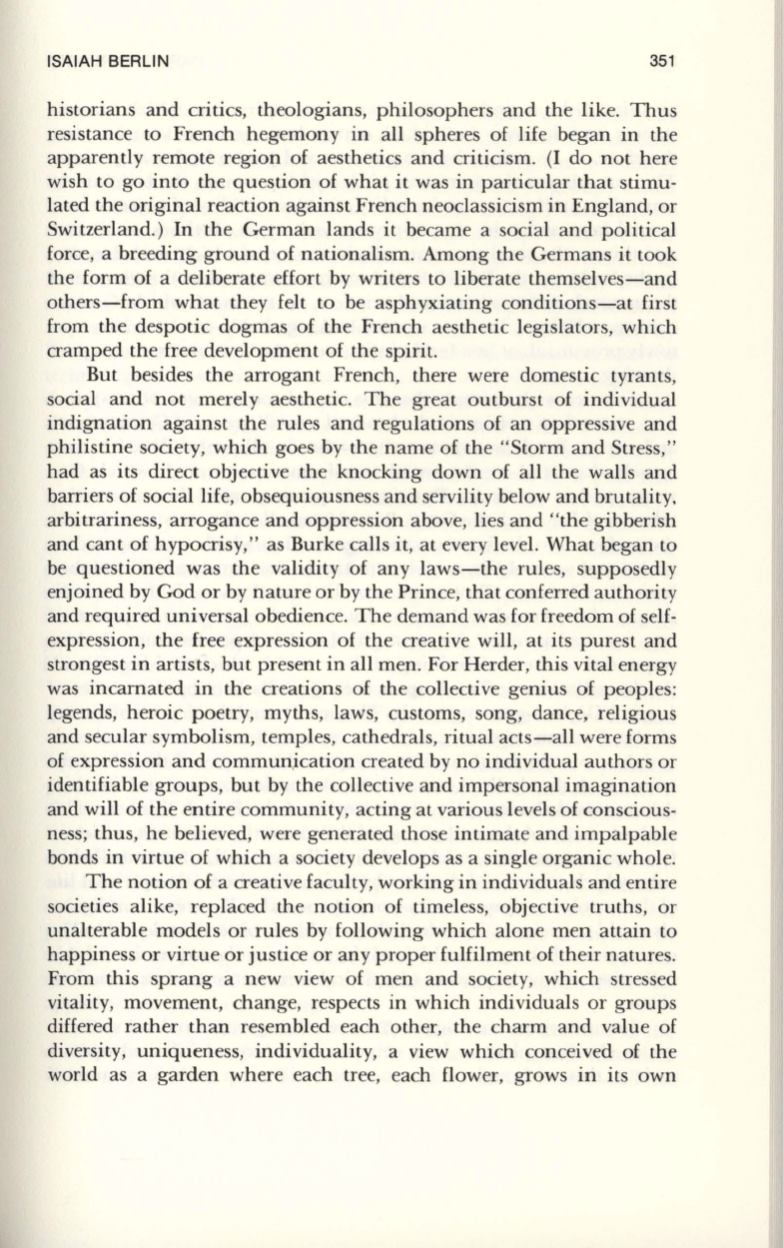
ISAIAH BERLIN
351
historians and critics, theologians, philosophers and the like. Thus
resistance to French hegemony in all spheres of life began in the
apparently remote region of aesthetics and criticism. (I do not here
wish to go into the question of what it was in particular that stimu–
lated the original reaction against French neoclassicism in England, or
Switzerland.) In the German lands it became a social and political
force, a breeding ground of nationalism. Among the Germans it took
the form of a deliberate effort by writers to liberate themselves-and
others-from what they felt to be asphyxiating conditions-at first
from the despotic dogmas of the French aesthetic legislators, which
cramped the free development of the spirit.
But besides the arrogant French, there were domestic tyrants,
social and not merely aesthetic. The great outburst of individual
indignation against the rules and regulations of an oppressive and
philistine society, which goes by the name of the " Storm and Stress, "
had as its direct objective the knocking down of all the walls and
barriers of social life, obsequiousness and servility below and brutality,
arbitrariness, arrogance and oppression above, lies and " the gibberish
and cant of hypocrisy, " as Burke calls it, at every level. What began to
be questioned was the validity of any laws-the rules, supposedly
enjoined by God or by nature or by the Prince, that conferred authority
and required universal obedience. The demand was for freedom of self–
expression, the free expression of the creative will, at its purest and
strongest in artists, but present in all men. For Herder, this vital energy
was incarnated in the creations of the collective genius of peoples :
legends, heroic poetry, myths, laws, customs, song, dance, religious
and secular symbolism, temples, cathedrals, ritual acts-all were forms
of expression and commun.ication created by no individual authors or
identifiable groups, but by the collective and impersonal imagination
and will of the entire community, acting at various levels of conscious–
ness; thus, he believed, were generated those intimate and impalpable
bonds in virtue of which a society develops as a single organic whole.
The notion of a creative faculty, working in individuals and entire
societies alike, replaoed the notion of timeless, objective truths, or
unalterable models or rules by following which alone men attain to
happiness or virtue or justice or any proper fulfilment of their natures.
From this sprang a new view of men and society, which stressed
vitality, movement, change, respects in which individuals or groups
differed rather than resembled each other, the charm and value of
diversity, uniqueness, individuality, a view which conceived of the
world as a garden where each tree, each flower, grows in its own


